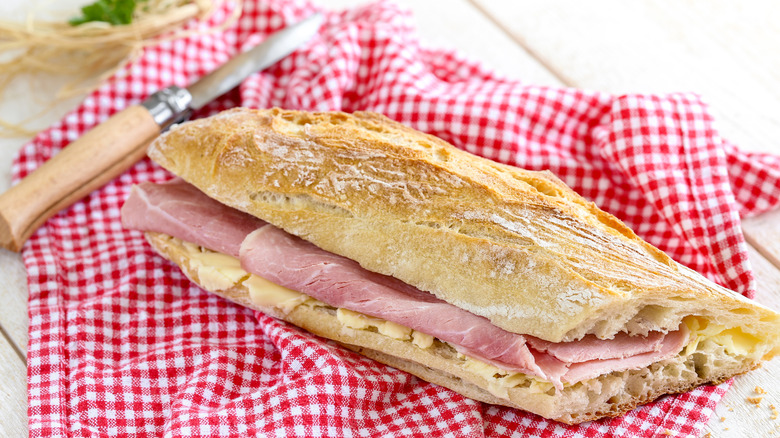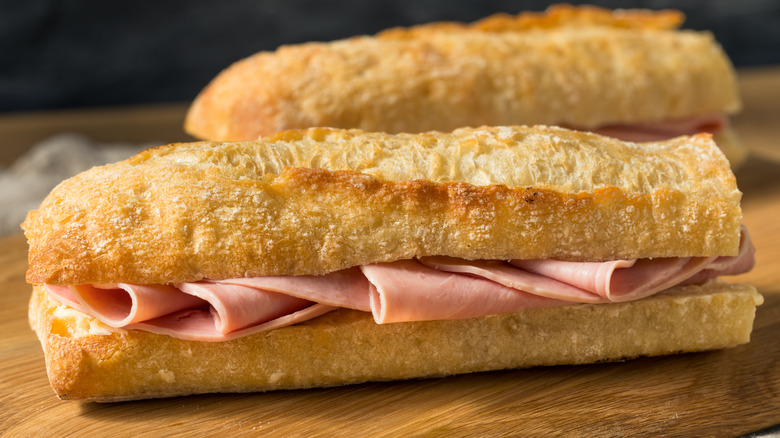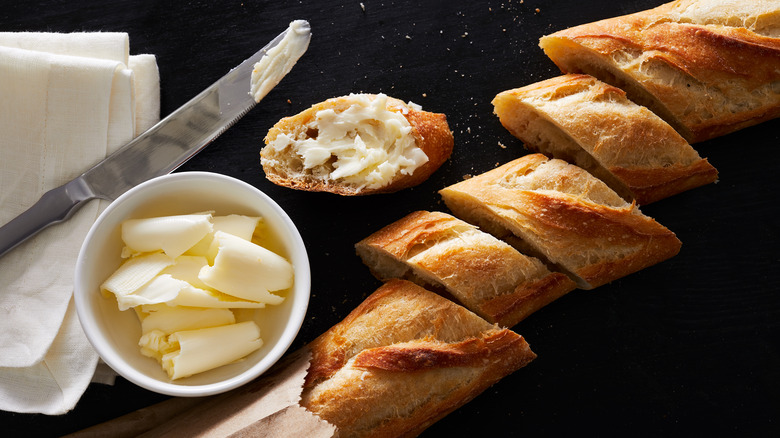Jambon-Beurre Sandwiches Are The Simple Paris Staple You Should Try
A good sandwich is a good sandwich, but a great sandwich is something else altogether. It's an alchemy of contrasting ingredients that come together to form a perfect meal. One of the best examples of this magic is the beguilingly simple and absolutely delicious (plus super Parisian) jambon-beurre sandwich. The jambon-beurre combines butter and ham on half of a rustic baguette. The sandwich can also be adorned with other toppings, such as the tangy cornichon, but usually, the sandwich is served as-is and needs no additions. Because of its use of quality ingredients and simple make-up, the jambon-beurre has become a staple food found in many delis and restaurants across France and serves as a good starting place for anyone hoping to become more acquainted with French cuisine.
Though its origins are foggy, the jambon-beurre was developed in the late 1800s and provided a quick and straightforward meal for an increasingly busy and mobile workforce. However, the sandwich really hit its stride by the middle of the 20th century, when baguettes became the bread of choice for many Parisians. The sandwich served as a quick and easy meal that was served at many restaurants at a low cost. The jambon-beurre might just be the most quintessentially French sandwich to exist besides the deliciously cheesy croque-monsieur. And the French would tend to agree, as they eat over 3 million a day according to a 2017 study by restaurant consultants Gira Conseil via AP. And though the jambon-beurre has recently been outsold by the hamburger, jambon-beurre still endures as a Parisian staple. And it exhibits the absolute best of what French cuisine has to offer.
How to make the most of your sandwich
Even the simplest dishes are taken seriously in France, so despite its short ingredient list, making a jambon-beurre isn't as simple as slapping together a few slices of deli ham onto some slathered-up white bread. Each ingredient of the sandwich is essential and should be approached with quality in mind.
For starters, the French baguette is essential; no other bread will do. The baguette, which is sliced in half and split down the middle, provides a delicious crust and structure that holds together the quick and convenient sandwich. And though baguettes aren't as flavorful as sourdough or rye, they provide the perfect canvas for your butter and ham.
Unlike the specified baguette, any ham can be used for your jambon-beurre, however, the preferred ham version in France is a smoked, cooked ham that is cut into thin slices. What you'll want to look for is quality. A slimy, grocery-store ham isn't going to cut it. Because of a jambon-beurre's simplicity, a good quality ham that can provide a heavy hit of salt and smokey flavor is required.
But perhaps the most essential part of this French sandwich is its simplest ingredient: butter. For many American diners, butter is often overlooked as a sandwich condiment in favor of toppings like a classic mayonnaise. However, butter is absolutely necessary for the simple but delicious jambon-beurre. The creamy tang of good French butter offsets the salty, rich flavor of the ham, and brings a luxurious smooth texture to the crunchiest of French baguettes. A quality (ideally French) butter can take your jambon-beurre from being just a ham sandwich to, well, something more.
For jambon-beurre, French butter is a must
The jambon-beurre calls for quality, unsalted butter, which should be spread thickly on a warm baguette, and for a truly authentic jambon-beurre, French butter is a must. But what makes French butter so special?
Well, the answer mostly comes down to fat content. European butter in general has a higher fat content than American butter; The New York Times explains that French butter specifically is required to have a minimum of 82% fat content. This is higher than the 80% fat content minimum in the United States. And though this 2% difference may seem small, the higher fat content makes for a creamier butter.
Additionally, French butter is a type of cultured butter, which is made by adding live and active bacteria cultures to cream similar to how yogurt is made. As a result, on top of being super creamy and rich, French butter has a slight zing, if you will, giving it a deeper, fuller flavor than American butter. The more complex flavors of French butter bring the sandwich to another level.
The importance of butter on a jambon-beurre proves that even the smallest details of a dish are worthy of attention. This attention to detail, and focus on quality ingredients, can make all the difference when constructing a killer sandwich. So regardless of whether or not your next sandwich is a jambon-beurre, it might be worth exploring the ingredients that make it so special.


